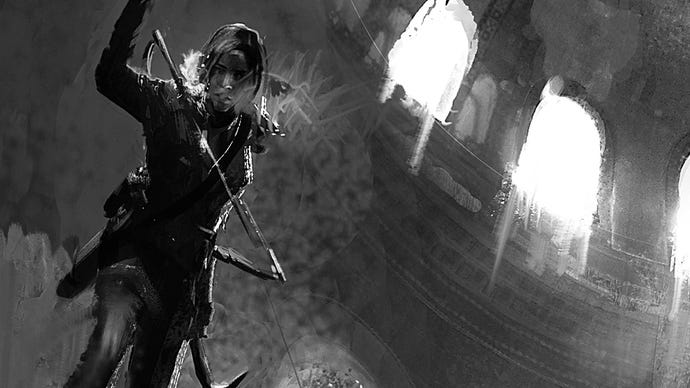Review: Rise of the Tomb Raider - greater than the sum of its parts
Lara adds up.
Rise is a high achievement and I wholeheartedly recommend you buy it. It represents genuine technical advancement for single-player third-person action games, and is, at times, as immersive and consuming as anything I've ever played.
I thought I’d let it sink in for a few days. I finished Rise of the Tomb Raider last Friday. It took me 21 hours, although I'm sure you could do it twice as quickly by concentrating only on the story markers. I wanted to see if I'd go back. I haven't yet, but only because I was given the chance of an HM Oryx kill in Destiny this weekend, so I spent about six hours on that (we failed, incidentally). Had I not been a Destiny tragic, I would have been plundering tombs. In fact, I've thought about little else since seeing Tomb Raider's credits.
Because Rise got me. If your eyes are a little bleary and it's late at night you can half forgive it for being realistic, so good is the action's animation and lighting. Lara thumps into walls and grunts as she clambers over ledges, always ready to go thermo with her bow. It's grand stuff, and its greatest achievement is its thrilling moodiness. Rise is a good example of console tech reaching a point at which characters are borderline believable, with controller systems and the mountain setting elevating the concept of “murder simulation” to a captivating level. You are in control of a super-woman capable of winding her way through forgotten installations and facing off against shock troops with brutal resolve, the visuals and superb sound engineering lending the heady mix a level of plausibility only now emerging on TV. At its best, Rise of the Tomb Raider’s action is purely exhilarating, with bear-men flinging themselves against lethal Lara and her unflinching deathliness, her bone-crunching ice axes and napalm arrows. One could recommend a purchase for the satisfaction of the combat alone.
But alone it is not. There are three main elements to Rise: combat, platforming (which also includes traversal and parkour) and exploration. It’s difficult to find serious fault with any component, to be frank, and I’ve been surprised to see negativity about Rise’s supposed failure to secure the "new" Tomb Raider's identity. The systems form the intended parquet. I never felt them to be disparate or jarring, but rather relished in the resultant epic, open adventure. There’s a huge amount of freedom in Rise, and you aren’t forced to approach the story at a particular speed. If you want to rinse in a certain section before you finish the plot, you can. I’m not sure how this lends itself to a lack of design confidence. I don’t agree it’s badly done.
What does Rise want to be? A multi-faceted adventure, surely, a stunning, seamless, unforgettable, next-generation journey. Of course you'll find hiccups, but Crystal Dynamics has been almost entirely successful. Rise is a fantastic, well-made game.
I’ll give you a brief summary of how the various elements pull together in a small, theoretical section of play. I’m putting off progressing with the story because there’s a Tomb entrance I want to find. I spend ten minutes hunting, but the area in which I’m searching is set over tall buildings and cliffs, and I’m probably missing something obvious. I decide to aim for the main mission marker and return later. After parkouring up to a roof, then shooting flathead arrows into multiple soft-wood sections to use as platforms, I use my ice axes to traverse a frozen cliff and access a flat approach to one of the larger, indoor goals. I’m now faced with waves of enemies - some armoured, some not; some who approach, some who hang back and snipe – in an arena situation in which I need to use crafting, healing, rifles, arrows, closer projectile weapons and melee attacks to kill all opponents before advancing. In a few minutes I’ve taken in exploration, platforming, traversal and combat, and each transition has been liquid. It’s an enjoyable, accomplished design. Variety doesn’t have to mean lack of focus, and in this instance it doesn’t. Rise is rich, not loose. If Tomb Raider’s goal is to deliver high adventure then it remains focused on it throughout, and the interlocking of its various systems results in a game more believable and truer to life – however fantastical that life may be - than its predecessor. Rise is a success.
The exploration is exploration (set in beautiful environments, both internal and external), and the platforming is sublime. I have little to say on it. It's superbly animated, the camera never leaves you hanging (as it were) and the jumping puzzles are ingenious, varied and fun. It's vastly more memorable than the previous game, and you'd have to be churlish to a Medieval degree to beat on Crystal Dynamics' work here.
The new combat is a little more complex, however, with innovations bringing both depth and ambiguity. The main addition is crafting, a major difference over the rebooted Tomb Raider, which allows the instant construction of a variety of weapons from objects during the fights themselves. You can now pick up bottles or cans and make bombs and Molotovs by holding RB, assuming you have the materials, and can also learn to make proximity mines from enemy radios.
Not only can you grab handily placed objects for bombing your foes: crafting primary and secondary ammo takes a few moments and can be done anywhere, meaning you don’t have to hunt around with too much urgency if you’re going into one of the tougher sections. It definitely lessens your chances of getting stuck, but this open access to ammunition may irk the purists.
You can also completely heal at any time using a craft assigned to LB. Of all the changes to second-to-second play over the previous game, this has a real, mollifying effect on combat. Provided you can stay away from the killing blow, you can patch Lara’s health immediately and continue with the fight. Even if you’re surrounded by armoured enemies, repeated dodging with the B button and a well-timed press of LB will have you out of the danger zone and up to full health every time.
My opinions on this are mixed. The Tomb Raider reboot was difficult in places, mainly because the only way to regain health was to stay safe. Rise’s combat is challenging, but, provided you have the materials to craft a health buff, you have a perpetual get-out clause. As soon as the healing controls click, standard difficulty becomes a cake-walk. That’s a good thing (“I won: yay!”), but it may disappoint those looking for a stiffer challenge. I haven’t turned up the hardness yet, but it’ll be interesting to see just how tough combat can be if you can heal so frequently. This access to near-unlimited health didn’t stymie my enjoyment, but if anything stands out as something to be looked over for the future, this is it.
Rise's main problem (even though it isn’t, really): you will see instances of stuttering and dropped frames. I’m sure technical journalists will quantify this after launch, but there are obvious occurrences of slow-down.
Whatever criticism you can level at specific elements of Rise's design, there's no question play's been hugely improved over the reboot, as has the underpinning story. Rise’s plot maybe takes a little while to get going, but at about the halfway point I became invested to the point of pleading with the game not to kill key characters. It's perhaps a little cheesy at times, but nowhere near so as the previous game, and Lara’s struggle, at points, becomes real. Her expressions are real. Her voice is real. She has place. Rise is epic in its scope, or at least in the intention of its scope, and Lara's isolation, framed by those dusky mountain shots, can hit you in the gut. She's believable and her road in Rise is long. I've dropped about 500 hours on Destiny's faceless monster-mashing infinity in the last year, and it's so refreshing to get involved in something that genuinely moved me.
I should talk about Rise's main problem (even though it isn’t, really) before I finish: you will see instances of stuttering and dropped frames. I’m sure technical journalists will quantify this after launch, but there are obvious occurrences of slow-down. I have no idea if this is caused by hardware or code, but it is there (or at least it was in the version I played, which, as far as I’m aware, was the full retail game). After spending so much time on Destiny this year and never seeing my PS4 bat an eyelid, it’s odd to be knocked back to reality in this way. Rise performed perfectly for me on the interior sections, and for the most part in all environments outdoors, but on occasion it did start juddering. I’m being really picky here. It didn’t affect my enjoyment one iota.
Nothing did, in fact. I don’t want to be overly negative about Rise, because I see it as high achievement and wholeheartedly recommend you buy it. It represents genuine technical advancement for single-player third-person action games, and is, at times, as immersive and consuming as anything I've ever played. The reboot was good, but this is just brilliant. Rag on it if you like, but I suspect history will judge Rise of the Tomb Raider kindly. You should play it.
Rise of the Tomb Raider releases this week in both the US and Europe. Check out a round-up of its major reviews.











